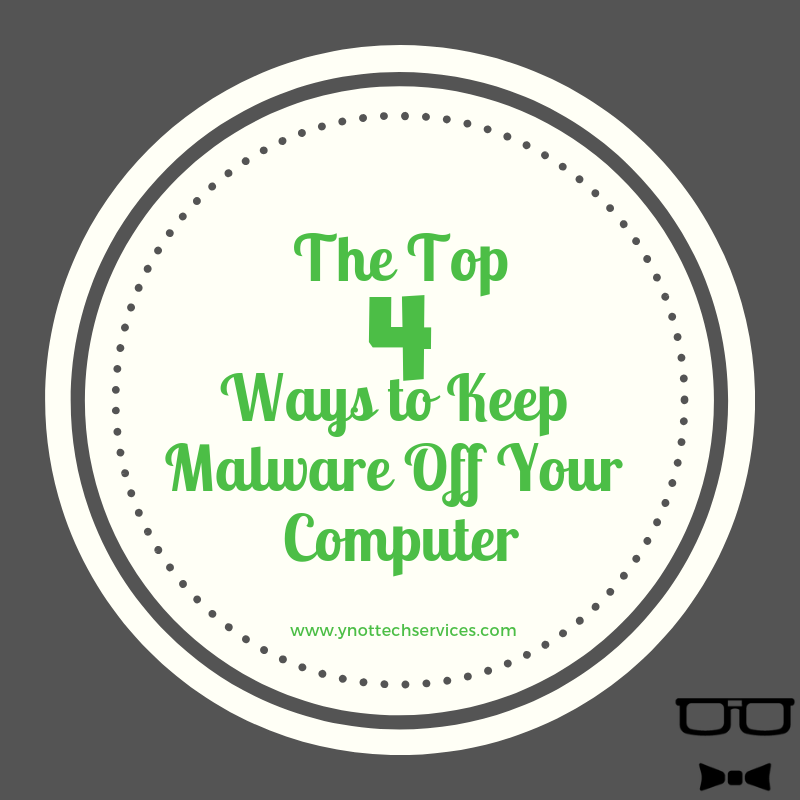
A malware infection on your computer is never fun. Lost time, repair costs, data loss, and frustration can all result from a single piece of malware or a virus on your computer. Y-Not Tech Services wants to help you avoid this problem with four tips to keep malware and viruses off your system.
Number One: Scan Your Computer Regularly
![]()
Your Anti-Virus software is your first line of defense when it comes to malware. A good anti-virus software will block most malware before it even gets on your computer. This is great, but sometimes newer pieces of malware won’t be blocked because your anti-virus hasn’t discovered that particular ‘strain’ of virus yet. This is where a regular scan with an up-to-date anti-virus comes into play. I like to set my anti-virus to do a quick scan daily and a full scan once a week. I try to schedule them while I’m not likely to be using my computer. If you don’t want to be bothered with your anti-virus software at all consider using Y-Not Tech Services’ Stress-Free Anti-Virus and we’ll deal with the details so you don’t need to.
Number Two: Keep Your Operating System and Programs Updated
 Cybercriminals are constantly probing and searching for flaws in computer systems to exploit. They regularly find these flaws in your Operating System (usually Windows or Mac OSX) and popular software programs that a lot of people have installed on their computers. Once a flaw is found the criminals start working to figure out how they can use it to their advantage – usually by using it to deliver malware to your computer. Once the malware is on your computer it can do all kinds of nasty things. While the criminals work to exploit it, the creators of the Operating System or software get to work fixing (or patching) the exploit. That patch will be released as an update to you so you can install the fix and keep your system safe.
Cybercriminals are constantly probing and searching for flaws in computer systems to exploit. They regularly find these flaws in your Operating System (usually Windows or Mac OSX) and popular software programs that a lot of people have installed on their computers. Once a flaw is found the criminals start working to figure out how they can use it to their advantage – usually by using it to deliver malware to your computer. Once the malware is on your computer it can do all kinds of nasty things. While the criminals work to exploit it, the creators of the Operating System or software get to work fixing (or patching) the exploit. That patch will be released as an update to you so you can install the fix and keep your system safe.
Windows users can subscribe to our proactive Gold Protection Plan that includes our Stress-Free Anti-Virus, Windows OS Update monitoring and Popular Application patching to help ensure you always have the latest security on your PC.
Number Three: Think Before You Click
Malware is commonly spread by messages containing links to malicious software or websites. These messages are spread through e-mail, Skype, Facebook, and other programs and will often come from someone on our friends list. This might mean that your friend’s account has been hijacked. It’s a good idea to contact them and suggest they change their password. Meanwhile, don’t click the link. It’s a good practice to hover to discover before clicking ANY link.
To Hover To Discover, simply hover your mouse over the link, but do not click. Leave your mouse hovering over it and take a look at the bottom of your browser window. You should see the full link URL address there. You can often tell a good link from a bad one by looking at the full address. The more your hover to discover the better you will get at identifying good links.
Number Four: Use an Ad Blocker
Most websites have ads displayed on them and most ads are harmless. However, some ads contain scripts designed to take you to a malicious website or download malware onto your computer. Some websites will ask you to turn off your ad blocker to view their content so they can make revenue to continue running the website. These requests are well-meaning since it does cost money to keep a website up, however, websites often don’t have control over the specific ads that run on their site, so it’s safest to keep blocking them.
Bonus: Keep a Good Back Up of Your Files
Sometimes, no matter how many precautions we take, malware infects our systems. If a good anti-virus program is your first line of defense, a good back up is your final defense against malware. If malware designed to delete or encrypt your files gets on your system, a good back up is like a Get Out of Jail Free card. And often times it’s the ONLY way out, so it’s vital that you keep a good back up.
If you need help with any of the steps above, Y-Not Tech Services is happy to help. Contact us using the form below or call us at 403-915-8574.


